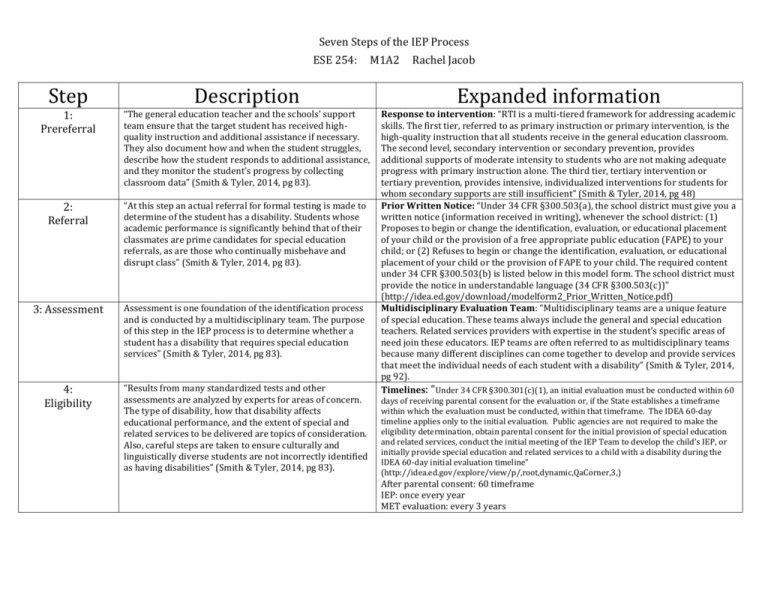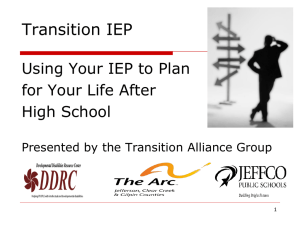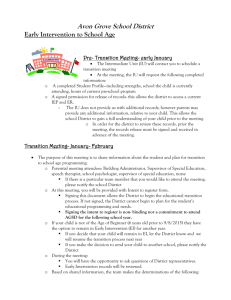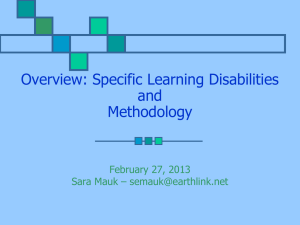File
advertisement

Seven Steps of the IEP Process ESE 254: M1A2 Rachel Jacob Step Description Expanded information 1: Prereferral “The general education teacher and the schools’ support team ensure that the target student has received highquality instruction and additional assistance if necessary. They also document how and when the student struggles, describe how the student responds to additional assistance, and they monitor the student’s progress by collecting classroom data” (Smith & Tyler, 2014, pg 83). 2: Referral “At this step an actual referral for formal testing is made to determine of the student has a disability. Students whose academic performance is significantly behind that of their classmates are prime candidates for special education referrals, as are those who continually misbehave and disrupt class” (Smith & Tyler, 2014, pg 83). 3: Assessment Assessment is one foundation of the identification process and is conducted by a multidisciplinary team. The purpose of this step in the IEP process is to determine whether a student has a disability that requires special education services” (Smith & Tyler, 2014, pg 83). 4: Eligibility “Results from many standardized tests and other assessments are analyzed by experts for areas of concern. The type of disability, how that disability affects educational performance, and the extent of special and related services to be delivered are topics of consideration. Also, careful steps are taken to ensure culturally and linguistically diverse students are not incorrectly identified as having disabilities” (Smith & Tyler, 2014, pg 83). Response to intervention: “RTI is a multi-tiered framework for addressing academic skills. The first tier, referred to as primary instruction or primary intervention, is the high-quality instruction that all students receive in the general education classroom. The second level, secondary intervention or secondary prevention, provides additional supports of moderate intensity to students who are not making adequate progress with primary instruction alone. The third tier, tertiary intervention or tertiary prevention, provides intensive, individualized interventions for students for whom secondary supports are still insufficient” (Smith & Tyler, 2014, pg 48) Prior Written Notice: “Under 34 CFR §300.503(a), the school district must give you a written notice (information received in writing), whenever the school district: (1) Proposes to begin or change the identification, evaluation, or educational placement of your child or the provision of a free appropriate public education (FAPE) to your child; or (2) Refuses to begin or change the identification, evaluation, or educational placement of your child or the provision of FAPE to your child. The required content under 34 CFR §300.503(b) is listed below in this model form. The school district must provide the notice in understandable language (34 CFR §300.503(c))” (http://idea.ed.gov/download/modelform2_Prior_Written_Notice.pdf) Multidisciplinary Evaluation Team: “Multidisciplinary teams are a unique feature of special education. These teams always include the general and special education teachers. Related services providers with expertise in the student’s specific areas of need join these educators. IEP teams are often referred to as multidisciplinary teams because many different disciplines can come together to develop and provide services that meet the individual needs of each student with a disability” (Smith & Tyler, 2014, pg 92). Timelines: “Under 34 CFR §300.301(c)(1), an initial evaluation must be conducted within 60 days of receiving parental consent for the evaluation or, if the State establishes a timeframe within which the evaluation must be conducted, within that timeframe. The IDEA 60-day timeline applies only to the initial evaluation. Public agencies are not required to make the eligibility determination, obtain parental consent for the initial provision of special education and related services, conduct the initial meeting of the IEP Team to develop the child’s IEP, or initially provide special education and related services to a child with a disability during the IDEA 60-day initial evaluation timeline” (http://idea.ed.gov/explore/view/p/,root,dynamic,QaCorner,3,) After parental consent: 60 timeframe IEP: once every year MET evaluation: every 3 years Seven Steps of the IEP Process ESE 254: M1A2 Rachel Jacob 5: IEP Development “For students who have a disability that requires special services, the multidisciplinary team and parents develop an individualized education plan. They determine the resources needed for the student to access the general education curriculum, list the goals for student and teachers to achieve, and outline the services and supports needed by the student” (Smith & Tyler, 2014, pg 83). Parental Rights and Safeguards: “The Individuals with Disabilities Education Act (IDEA), the Federal law concerning the education of students with disabilities, requires schools to provide parents of a child with a disability with a notice containing a full explanation of the procedural safeguards available under the IDEA and U.S. Department of Education regulations. A copy of this notice must be given to parents only one time a school year, except that a copy must be given to the parents: (1) upon initial referral or parent request for evaluation; (2) upon receipt of the first State complaint under 34 CFR §§300.151 through 300.153 and upon receipt of the first due process complaint under §300.507 in a school year; (3) when a decision is made to take a disciplinary action that constitutes a change of placement; and (4) upon parent request. [34 CFR §300.504(a)]” (http://www.azed.gov/specialeducation/files/2011/09/procedural-safeguards-07-2013.pdf) 6: IEP Implementation “The IEP details what comprises an appropriate education, maximum participation in the general education curriculum, supported by the accommodations both for instruction and for assessment, and provision of related services that support the student’s education program” (Smith & Tyler, 2014, pg 83). 7: Evaluation and Reviews “In most states, students’ IEPs are reviewed annually to ensure that students are meeting their goals and making educational progress; in some states they are reviewed every three years. Some students may no longer need or qualify for special education services; others may need a new IEP and different services; and for some students, the IEP is updated and revised” (Smith & Tyler, 2014, pg 83). Entitlement to a Free and Appropriate Public Education: “Free and appropriate public education (FAPE) and least restrictive environment (LRE) allow students with disabilities the most access to the general education curriculum and the least amount of segregation possible [without cost to the family]” (Smith & Tyler, 2014, pg 84, italics from glossary) “FAPE is individually determined because what is appropriate for one student with a disability might not be appropriate for another” (Smith & Tyler, 2014, pg 16). Transition plans: “(A) is designed to be a results-oriented process, that is focused on improving the academic and functional achievement of the child with a disability to facilitate the child's movement from school to post-school activities, including post-secondary education, vocational education, integrated employment (including supported employment), continuing and adult education, adult services, independent living, or community participation; (B) is based on the individual child’s needs, taking into account the child's strengths, preferences, and interests; (C) includes instruction, related services, community experiences, the development of employment and other post-school adult living objectives, and, when appropriate, acquisition of daily living skills and functional vocational evaluation” (http://www.wrightslaw.com/info/trans.index.htm). “”The more that is known about the receiving settings and about the student’s levels of competence to deal with these settings, the more likely a seamless transition can be achieved…Student involvement in the transition-planning process is not only highly desirable but also required by law” (Vaughn & Bos, 2015, pg 14)






